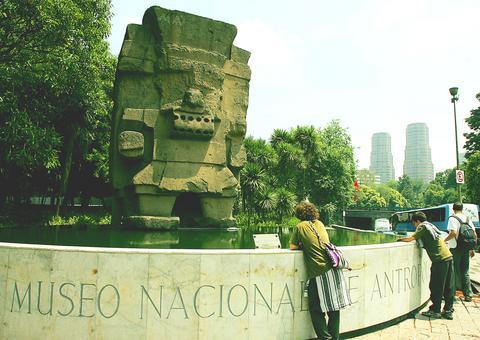The mythical homeland of Mexico's Aztecs -- an island known as Aztlan -- has eluded historians for centuries, and the quest to find it has become shrouded in political spin and scholarly speculation.
Like the lost Atlantis and Camelot, Aztlan may or may not have existed, but fervent believers have sought it from the desert of Utah to a mangrove swamp in western Mexico.

PHOTO: REUTERS
Academics agree that the Aztecs, a warlike tribe with a passion for human sacrifice, wandered the badlands of central Mexico for years before founding what is now Mexico City around 1325 and then forging the greatest empire of the ancient Americas.
But the original habitat of the people whose history and symbols are still invoked by modern Mexico remains a mystery.
Aztec legend says little about Aztlan, apart from that it was a small island on a lake inhabited by herons north of Mexico City. If it is ever found, archaeologists do not expect to discover much in the way of treasure or ruins there.
The small western state of Nayarit, long neglected by the federal government, declared itself the "cradle of the Mexicans" in the early 1990s based on an old theory that the marshy island of Mexcaltitan was in fact Aztlan.
Little stirs on the mosquito-infested islet which nestles in a salt water lagoon on the Pacific coast.
An expected tourism boom to the state has mostly failed to materialize and the islanders still scratch a living from fishing for shrimp and lobsters.
"No serious archeological study has ever been done in Mexcaltitan," said Jesus Jauregui, an expert in western Mexico at the National Institute of Anthropology and History.
"Aztlan is a mythical place, not an historical one," he said.
SPEAKING in TONGUEs
Try telling that to the growing number of Mexican immigrants in the US for whom the idea that Aztlan was in Utah or Colorado has become a matter of doctrine.
"Mexican Americans are very interested in it because it gives them identity as an ethnic group," said Armando Solorzano, ethnic studies professor at the University of Utah.
He said that if the Aztecs indeed came from what is now the western US, as some linguistic studies suggest, then the millions of mostly illegal Mexican migrants there could argue that they are not just undocumented workers but descendants of the original inhabitants who have come home.
"With this massive wave of immigration from Mexico now, the immigrants are saying, `We are returning to Aztlan,' so there is a lot of political misunderstanding and conflict," Solorzano said.
Many Mexicans still resent the US taking much of the US Southwest in the 1846 to 1848 Mexican-American war.
Perhaps the best clue to the origins of the Aztecs is the language.
The Aztec tongue is widely recognized by linguists as being part of the Uto-Aztecan family and related to the language of the Ute Indians of Utah as well as the Hopi and Comanche.
The discovery in recent years of a cave painting in Sego Canyon, Utah that appears to be a deity also seen on a famous Aztec stone calendar boosts the theory of a former Aztec presence in the US, Solorzano said.
Seven caves found on Antelope Island in Utah may also tie in with an Aztec story that the tribe passed through a place of seven caves, the fabled Chicomoztoc, he said.
But all this does not prove that Aztlan was in the southwest US, only that the Aztecs may have spent time there on their wanderings before departing for Mexico City some 2,736km to the south.
"This is one point of departure. Nayarit might be another one. Some people say they also migrated from California," Solorzano said. "There is another belief that the Aztecs came from Florida," he said.
Mexcaltitan, home to 1,800 people in a mangrove swamp, is now losing ground to US claims to be the Aztecs' homeland.
Even the curator of the island's tiny museum acknowledges that the local version of the Aztlan story may be fiction.
ISLAND HOME
"The issue of where the mythical Aztlan is has been thrashed about a lot. They haven't located it definitively," said curator Lilia Apocada.
The island was first tapped as Aztlan by a 19th century Mexican historian and given credence by National Geographic magazine in a 1968 article.
Mexcaltitan's tiny museum houses some pre-Hispanic pottery but no evidence that it was the place from where the Aztecs took their first step into the history books.
Locals are more concerned about shrimp fishing and preparations for the annual festival when the island's population triples for a few days of dancing and heavy drinking at the end of June.
"They say the Aztecs passed through here. Well, I didn't see them," said fish gutter Abelardo Ramos, 38.
The doors of houses are often left open in Mexcaltitan, unlike in crime-ridden areas of Mexico, and families laze in hammocks, eating seafood or drinking cold beer.
"Whether it is the real Aztlan or not, people enjoy this place anyway," said museum curator Apocada.

June 2 to June 8 Taiwan’s woodcutters believe that if they see even one speck of red in their cooked rice, no matter how small, an accident is going to happen. Peng Chin-tian (彭錦田) swears that this has proven to be true at every stop during his decades-long career in the logging industry. Along with mining, timber harvesting was once considered the most dangerous profession in Taiwan. Not only were mishaps common during all stages of processing, it was difficult to transport the injured to get medical treatment. Many died during the arduous journey. Peng recounts some of his accidents in

“Why does Taiwan identity decline?”a group of researchers lead by University of Nevada political scientist Austin Wang (王宏恩) asked in a recent paper. After all, it is not difficult to explain the rise in Taiwanese identity after the early 1990s. But no model predicted its decline during the 2016-2018 period, they say. After testing various alternative explanations, Wang et al argue that the fall-off in Taiwanese identity during that period is related to voter hedging based on the performance of the Democratic Progressive Party (DPP). Since the DPP is perceived as the guardian of Taiwan identity, when it performs well,

The Taiwan People’s Party (TPP) on May 18 held a rally in Taichung to mark the anniversary of President William Lai’s (賴清德) inauguration on May 20. The title of the rally could be loosely translated to “May 18 recall fraudulent goods” (518退貨ㄌㄨㄚˋ!). Unlike in English, where the terms are the same, “recall” (退貨) in this context refers to product recalls due to damaged, defective or fraudulent merchandise, not the political recalls (罷免) currently dominating the headlines. I attended the rally to determine if the impression was correct that the TPP under party Chairman Huang Kuo-Chang (黃國昌) had little of a

At Computex 2025, Nvidia CEO Jensen Huang (黃仁勳) urged the government to subsidize AI. “All schools in Taiwan must integrate AI into their curricula,” he declared. A few months earlier, he said, “If I were a student today, I’d immediately start using tools like ChatGPT, Gemini Pro and Grok to learn, write and accelerate my thinking.” Huang sees the AI-bullet train leaving the station. And as one of its drivers, he’s worried about youth not getting on board — bad for their careers, and bad for his workforce. As a semiconductor supply-chain powerhouse and AI hub wannabe, Taiwan is seeing